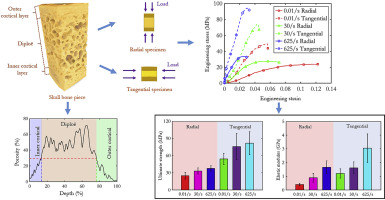Journal of the Mechanical Behavior of Biomedical Materials ( IF 3.9 ) Pub Date : 2019-12-17 , DOI: 10.1016/j.jmbbm.2019.103597 Xuedong Zhai 1 , Eric A Nauman 2 , Dana Moryl 3 , Roy Lycke 3 , Weinong W Chen 4

|
Most fatal human skull injuries occur under impact loading conditions, such as car collisions, where the strain rates fall in the range of intermediate (1/s−102/s) and high (102/s−103/s) rates. Therefore, knowledge of the mechanical behaviors of human cranial bone at higher strain rates, i.e., intermediate and high strain rates, may provide insight into the prevention of skull injuries and help the design of efficient head protection systems. In the present study, the compressive mechanical behaviors of human frontal skull bone along and perpendicular to its through-the-thickness direction were experimentally characterized at quasi-static (0.01/s), intermediate (30/s) and high (625/s) strain rates in this study. A total number of 75 specimens prepared from three male donors with ages of 70–74 were separated into three groups: quasi-static (N = 23), intermediate (N = 23), and high (N = 29) strain rates. Experiments at quasi-static and intermediate strain rates were performed using a hydraulically driven materials testing system (MTS), while a Kolsky compression bar was used to load the skull bone specimen at high strain rates. X-ray computed tomography was performed to obtain the structural parameters and visualize the microstructures of the skull bone. The in-situ failure processes of the specimens under high-rate loading were documented by a high-speed camera. The human skull exhibited a loading-direction dependent mechanical behavior, as higher ultimate strength and elastic modulus were found in the direction perpendicular to the thickness when compared with those along the thickness direction, exhibiting an increasing ratio as high as 2 and 3 for strength and modulus, respectively. High-speed images revealed that the specimens loaded along the thickness direction generally failed due to the crushing in diploë (the trabecular bone tissue) whereas separation of the entire architecture was observed as the main failure mode when compressed in the perpendicular direction. The effect of loading rate was also evident: the skull specimens were increasingly brittle as strain rate increased from quasi-static to high rate for both the loading directions. The elastic modulus increased by a factor of 4 in radial direction and it increased by a factor of 2.5 in the tangential direction across the quasi-static, intermediate and high strain rates. Significant differences were also found in ultimate strength and work to failure as loading rate increased from quasi-static to high rates. The results also suggested that the strength in the radial direction was mainly depended on the diploë porosity while the diploë layer ratio played the predominant role in tangential direction.
中文翻译:

加载方向和应变率对人类额骨颅骨力学行为的影响。
大多数致命的人头骨伤害发生在冲击载荷条件下,例如汽车碰撞,应变率落在中等(1 / s−10 2 / s)和高(10 2 / s−10 3)范围内/ s)费率。因此,了解人颅骨在较高应变率(即中等应变率和高应变率)下的机械行为,可以为预防颅骨损伤提供见识,并有助于设计有效的头部保护系统。在本研究中,实验性地表征了人类额叶颅骨沿厚度方向并垂直于其厚度方向的压缩力学行为,其特性为准静态(0.01 / s),中级(30 / s)和高(625 / s) )的应变率。由三位年龄为70-74岁的男性供体准备的75个标本分为三组:准静态(N = 23),中级(N = 23)和高(N = 29)应变率。使用液压驱动的材料测试系统(MTS)在准静态和中等应变率下进行了实验,同时使用了Kolsky压缩杆以高应变率加载了颅骨标本。进行X射线计算机断层扫描以获取结构参数并可视化颅骨的微观结构。在原位用高速相机记录了高速加载下样品的破坏过程。人类头骨表现出与加载方向有关的机械行为,因为与沿厚度方向的方向相比,在垂直于厚度的方向上发现了更高的极限强度和弹性模量,强度和强度的增加率分别为2和3。模数分别。高速图像显示,沿厚度方向加载的标本通常由于双壁(小梁骨组织)的压裂而失败,而在垂直方向压缩时,观察到整个体系结构的分离是主要的破坏模式。加载速率的影响也很明显:随着两个加载方向上的应变率从准静态提高到高速率,头骨标本变得越来越脆。弹性模量在径向上增加了4倍,在切向方向上在准静态,中等和高应变率下增加了2.5倍。随着加载速率从准静态提高到高速率,最终强度和工作至破坏之间也存在显着差异。结果还表明,径向强度主要取决于双孔孔隙率,而双层比在切向方向上起主要作用。中高应变率。随着加载速率从准静态提高到高速率,最终强度和工作至破坏的能力也存在显着差异。结果还表明,径向强度主要取决于双孔孔隙率,而双层比在切向方向上起主要作用。中高应变率。随着加载速率从准静态提高到高速率,最终强度和工作至破坏之间也存在显着差异。结果还表明,径向强度主要取决于双孔孔隙率,而双层比在切向方向上起主要作用。



























 京公网安备 11010802027423号
京公网安备 11010802027423号